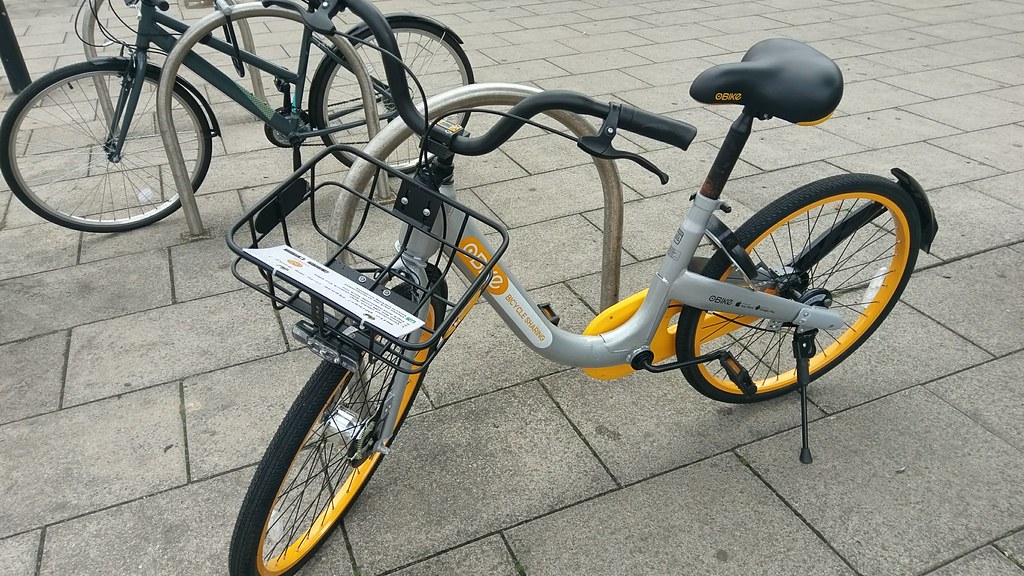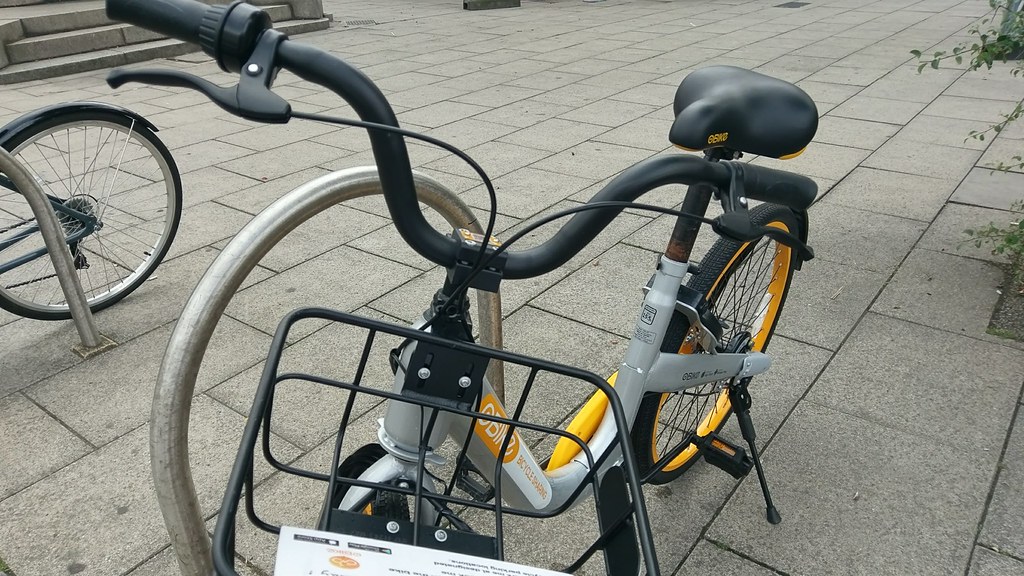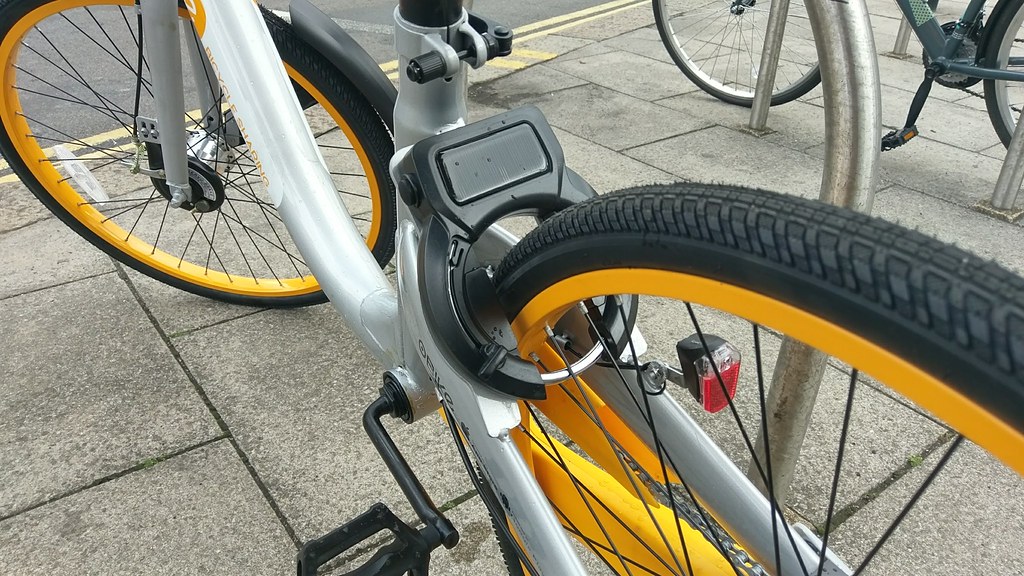On Saturday night, I was returning to my north London home when I noticed something I’d not seen before – a new type of hire bike.
Now us Londoners have become used to “Boris Bikes” – or Santander Cycles as they’re officially known. This is a scheme that I’ve been using fairly consistently since its start, using the bikes to traverse central London if I don’t have my own bike with me. London has a network of docking stations, and you can take a bike from one station and lock it up somewhere else. The scheme works well, and is certainly useful for commuting. If you arrive in London at a mainline railway station, you may complete your journey on a bike. Or if you live in Zone 1 or 2 – the central area of London where most of the docks are to be found – you might carry out all your commute on a bike. They’re popular with tourists too – especially in some of the larger parks like Hyde Park.
But there are some significant flaws, or at least shortcomings.
You can only really use the bikes within the area that has had docks built. This is largely Zone 1 and 2 in the middle of London. And while the bikes extend a fair way east to Docklands, they don’t extend that far in other directions. They don’t even extend as far as the inner gyratory road system, let alone straying into the outer boroughs.
You have to return the bike to a docking station, and they can often be full in popular locations. While a mobile app can help you a little with that, the flow of bikes is such that a team of vans has to move bikes around to prevent key spots being filled all the time. The bikes are also fairly heavy, but they come with three gears, so while you won’t be racing too much on them, you can get pretty much anywhere.
But back to the oBikes. I asked the proprietor of the shop I was in on Saturday evening, how long the bike had been there. He said that it was the council that had put the bikes out (this is very much not true), and that the where many along the entire street. When I left the shop, I saw that on a closer inspection, there were several more along the length of the road.
Well, always keen to give a new bike scheme a go, I pulled my phone out, downloaded the requisite app, registered my card details, and tried to release a bike. The app seemed comprehensive, if a tiny bit confusing at times. There was some kind of deal on giving free hires, but it really wasn’t clear from the app because you could click through to get the details. I paid a £29 deposit and then got a free hire. It seems that in fact, hiring remains free for the remainder of July, but I only learnt this later on the website.
While the bikes aren’t locked to any physical infrastructure, their rear hub is locked in place until it’s released wirelessly. Using the app, you can locate the rough whereabouts of a free bike, although in practice I found that the GPS coordinates could be up to 100m out. You then scan your phone on a QR code on the stem of the bike and a few seconds later – mobile data permitting – the lock on the hub is released. A trigger physically pinging up.
The mobile app warns you to wear a helmet, and ensure that the rear light is switched on. But in fact, the lights seem to come automatically, powered by a dynamo system when the bike is moved. While Boris Bikes’ lights work on a similar basis, they seem to store more residual power meaning that lights start immediately when you move. Even with the low demands of LED lighting, these lights seem more ineffective, especially when you set off.
What about the bikes themselves?
Well, they’re awful.
On the plus side, they’re much lighter than Boris Bikes, and they have a proper basket on the front rather than the often irritating affair that Boris Bikes have, that require a bungee cord to hold bags in place. But beyond that, I have no good things to say about the actual bikes.
They’re clearly cheaply made. There’s a single gear, and somehow it doesn’t seem suitable for anything other than a really slow potter around. It feels incredibly spongy too – something that a fixed gear bike really shouldn’t feel.
The seat post goes from low, to not-quite-as-low. Now I realise that at 6 foot 2 inches, I’m not the shortest person. But for me, this was like riding a BMX. My knees were nearly at the handlebars, and it was generally incredibly inefficient for me to cycle on. Indeed anyone much over 5 foot 10 may struggle with these bikes.
There’s a feeble bell rung by a twist-grip affair. Nobody is going to hear it. At least the hub brakes did seem to work well. The bikes have mudguards of sorts, but they’ve tried to remove as much surplus plastic as possible meaning that there’s very little real protection. I wouldn’t want to ride one of these in the wet without completely covering myself with muck.
Overall the bike felt like one those awful super-cheap supermarket bikes that I’d never recommend anyone ride, no matter how little money they had to spend. And at least those bikes have some gears.
Now I live at the top of a hill. It’s not a steep hill, and nor is it a long hill. In fact it’s 900m at an average gradient of 4%. While you feel that in your legs, it’s not going to stop the average cyclist comfortably riding up it. I can do this on my Brompton with extra shopping bags hanging off my handlebars.
But using the oBike I struggled. I mean I really struggled. The single gear was neither fish nor foul, and the uncomfortable riding position didn’t help. I ended up cycling on the pavement as I was going so slowly. In the end I gave up. I parked up in a responsible location and ended my ride, locking the bike by pushing a trigger down over the hub. My phone beeped as the app acknowledged that my bike hire had come to an end.
I was very unimpressed.
The following morning, however, I needed to get back down the hill and then travel further into my local town centre to catch a train. It would be tight walking there in time, but as I came back down the hill, I saw that the bike I’d parked the previous night was still there. So I unlocked it once more, and took it out for another ride.
Going down the hill was fine, although I still felt as though I was riding a BMX, and found myself having to get out of the saddle to stretch out my legs. I rarely get out of the saddle on Boris Bike, which seems much more suited to carrying a wider range of differently sized people. I don’t even max-out the seatpost on those bikes meaning that riders of perhaps up to 6 foot 4 can comfortably ride them.
On reaching the flat, the limitations of the single gear were once again in evidence. I have no idea what gear the bikes are, but again I found it incredibly slow going. It took me much longer to get to my destination than it would have done on any other bike. And it was much harder work as well.
I parked the bike up by some Sheffield stands in the town centre quietly vowing not to use the bikes again. As I did so, two separate people came up to ask me about the bike. What was obvious was that the lack of a requirement to dock the bike somewhere specific was popular. “It’s like Uber, for bikes!” said one man.
However I had to tell both people that I thought it was only good for travelling somewhere very flat, that it was not for tall people, and that nobody was going to get somewhere very fast with one of these bikes.
Subsequently I learnt that although hundreds of bikes had appeared across London the week before, no permission had been sought from any council to run the scheme. While it’s not completely clear why council approval would be required, there is almost certainly concern for how the bikes are treated, and in particular, where they are left. There are horror stories in China, where these bikes are made, and where this type of hire scheme has become prevalent, about hundreds of bikes being literally piled up on pavements near places like stations. In some instances pedestrians struggle to walk along pavements to avoid thoughtlessly placed bikes.
All the bikes I’ve seen so far have been left in decent places, often by existing bike stands. But I can see why many would prefer the more ordered system that Boris Bikes use.
There’s also the question of people vandalising the bikes. Although the hubs lock the rear wheels, the bikes can easily be lifted and placed somewhere else. A similar scheme in Manchester has already seen a number of bikes ending up in canals, and my borough has the New River – effectively a non-navigable canal.
I do feel a little torn about the oBike scheme. On the one hand, I’m very much for encouraging bike use, and my local council is doing a lot for bikes, building new cycle lanes in the face of sometimes quite hostile local opposition. But a badly run bike hire scheme is probably not the answer either.
It certainly feels that the Singapore-based company that launched these bikes has bought the cheapest bikes they could get in China, and not remotely considered local needs. While dockless schemes seem like an excellent idea, in that it reduces the costs dramatically since there’s no infrastructure required, I worry that it also means doing things on the cheap, and not worrying unduly about the social and environmental consequences.
And a bad scheme can have a significantly negative impact on cycling as a whole. If people find bikes abandoned in inappropriate locations, then they will take against the scheme. Similarly, would-be cyclists might well be put off from cycling after experiencing poor quality bikes that don’t make travel easy. These bikes are not a good introduction to cycling, whereas I would argue that while heavy, Boris Bikes are a decent introduction, and may well have persuaded many to invest in their own bikes and cycle more as a result (I’m hoping the upcoming replacement model will be even better).
The reaction overall has not been positive thus far, and in fact my local council has reached an agreement for the bikes to be removed locally pending a wider conversation about how the bike scheme should work. I believe that the same is happening in other London boroughs.
While Boris Bikes were a TfL initiative, and cost millions to set-up, and require continued investment to maintain, the scheme has been well conceived, and there is full support as well as maintenance of the equipment. The bikes, currently manufactured by Canadian company, and seen in other cities such as New York, are well suited to their environment and in general are a boon to encouraging cycling as a form of transport. It’s worth noting that for TfL, cycling is not just a “nice-to-have” but an essential part of London’s transport mix. Every cyclist on the road is one less tube passenger for example. I can’t say the same for oBikes.
This morning, as I got on the train at my local station, at the top of the same hill I live on, I noticed someone had parked a bike by the station to get their train. All I can do is give kudos to whoever rode that bike up the hill this morning!



